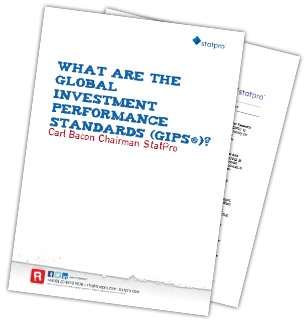StatPro recently joined Australia’s Financial Services Council, the peer organization that represents Australia’s retail and wholesale funds management businesses, superannuation funds, life insurers and financial advisory networks.
The organisation ran and published the results of a survey of members of its P Group last year to find out more about its members’ attitudes towards GIPS and GIPS compliance. The FSC P Group is a forum for investment professionals to discuss and develop ideas, concepts and theories relating to performance measurement and analysis. (And I was recently in Australia providing GIPS and standards training to members of the P Group.)
The responses are interesting. Compliance is claimed to be up 92%, and there seems to be a strong consensus from those surveyed that GIPS compliance improves the quality of investment performance (not just investment reporting).
And the view from those surveyed was that there are tangible marketing benefits from being GIPS compliant.
But opposing this positive attitude is the inevitable concern about the cost of compliance, which the fund managers and asset consultants always balance against the benefits they get in return.
And I’m sure such concerns play out across other markets and regions, including Asia.
Yet it remains important to reiterate the benefits of GIPS. At their core, GIPS provide certainty. And in uncertain times, investors crave certainty above all else.
Investors the world over will increasingly demand more accuracy and context in the information they are given by their investment managers in the current era of renewed market volatility. Volatility and uncertainty in all aspects of financial services are clearly not going to recede any time soon.
The aging populations around the world, especially those from middle classes who are now approaching their baby-boom retirements, are less able to accommodate another financial meltdown, and less likely accept such a scenario, particularly if it’s now the latest in a recurring series of crises.
(Investors might well recall the observation made by Auric Goldfinger in the James Bond novel: once is happenstance, twice is coincidence, the third time is enemy action!)
They will vote with their investments, and governments will likely make it easier for investors to do this without penalty, to promote competition.
Those investment managers and intermediaries who understand the benefits of demonstrating credible results and credible claims for fund performance, and present their data and information to their clients in a credible way, will attract more clients and more capital. The cost/benefit balance then becomes a marketing investment rather than a compliance overhead.
So, on this theme of taking a broader view, here are five benefits of GIPS compliance couched in positive cost/benefit balance language:
1. A systematic, objective and accountable way of presenting investment information that does not require investment managers to invest time and cost in creating a bespoke alternative
2. Predictable verification costs and processes
3. Time and focus to devote to client engagement, relationship development and investment portfolio management, and on the creation of positive and beneficial differentiation, rather than on compliance management
4. Increasing opportunities to exploit the benefits created at a national level more widely in other regions or countries
5. The opportunity to generate more management fees as a consequence of having the predictability and certainty of this “credibility engine”
Striking the balance is always a business challenge. However, fortune favours the brave: those that recognise GIPS as a marketing investment and not a compliance cost will steal an advantage.
Yet on my recent visit to Australia, I still saw a reluctance by Australian funds to insist on GIPS, by fund managers to implement GIPS, and asset consultants to recommend GIPS.
In Australia and around the world, the mind-set around the cost-benefit balance of implementing GIPS must change. And the benefits go way beyond those of being seen to be compliant.
Compliance actually shines a light on those risk outliers lurking on the periphery of many funds, leading to inherently better risk control. In the GIPS process, these outliers are identified and investigated, ensuring portfolios have been allocated to the correct composites, ensuring managers are following the correct investment strategies and ensuring errors are identified.
It is, after all, better to mitigate those outliers with knowledge aforethought, rather than in hindsight.
GIPS lays down appropriate foundations for required policies and procedures. This means better data, of better quality data, leading to better analysis.
And the adherence to the higher ethical standards implicit in GIPS sends a clear, positive, unequivocal signal to clients, regulators and competitors.
